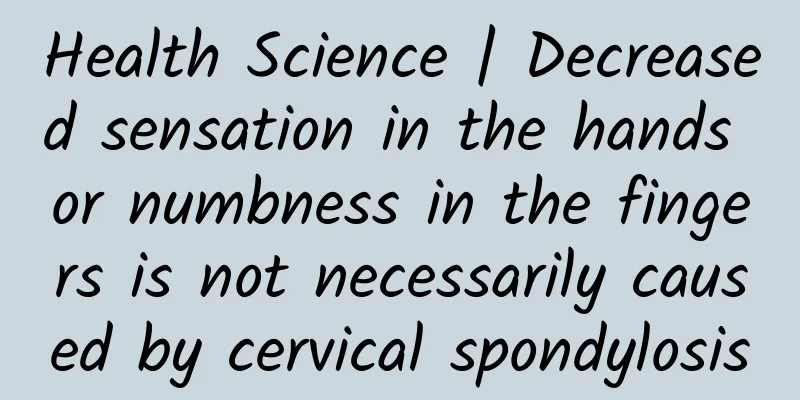Health Science | Decreased sensation in the hands or numbness in the fingers is not necessarily caused by cervical spondylosis

|
Many people say, "Loss of sensation in the hands or numbness in the fingers is caused by cervical spondylosis." This statement is not entirely correct. As we age, the neck will have bone hyperplasia, ligament hardening, and intervertebral disc herniation. After the nerves in the neck are compressed, there will indeed be decreased sensation, numbness and other discomforts in the hands. But in fact, the median nerve, radial nerve, and ulnar nerve that control our hands pass through other narrow parts. After being compressed, there will also be decreased sensation, numbness and other discomforts in the corresponding control areas. For example, carpal tunnel syndrome and cubital tunnel syndrome. Carpal Tunnel Syndrome is the most common peripheral nerve compression disease. Carpal tunnel syndrome is caused by increased pressure in the carpal tunnel, which causes the median nerve to be compressed. The incidence of carpal tunnel syndrome is higher in women than in men. Common symptoms include paresthesia and/or numbness in the median nerve innervation area (thumb, index finger, middle finger and radial half of ring finger). Finger numbness at night is often the first symptom of carpal tunnel syndrome. Many patients have experienced waking up with numb fingers at night. Many patients can relieve the discomfort of finger numbness to a certain extent by changing the posture of the upper limb or shaking the hand. Patients may also aggravate finger numbness when engaging in certain activities during the day, such as sewing, driving, holding the phone for a long time, or holding a book for a long time. Some patients only feel numbness and discomfort in the middle finger or middle and ring finger tips in the early stage, and only in the later stage do they feel numbness and discomfort in the thumb, index finger, middle finger and radial half of the ring finger. Some patients may also have numbness or paresthesia in the forearm or even the entire upper limb, and even feel that these symptoms are the main discomfort. As the disease worsens, patients may experience definite decreased or lost sensation in their fingers, and atrophy or weakness of the abductor pollicis brevis and opponens pollicis muscles. Patients may experience atrophy of the radial muscles of the thenar eminence, inflexibility of the thumb, decreased strength in pinching with other fingers, or even inability to complete pinching movements. There are two main treatment methods: non-surgical and surgical. There are many non-surgical treatment methods, including brace immobilization and corticosteroid injections. Surgical treatment includes various incisions, small incision decompression, and endoscopic surgery, etc., the purpose of which is to loosen the carpal tunnel and relieve compression. The ulnar nerve is compressed due to traumatic arthritis of the elbow. There is a thickened fibrous band between the two ends of the ulnar flexor carpi, which compresses the ulnar nerve. This is called cubital tunnel syndrome. Elbow fractures and elbow valgus deformity, ulnar nerve traction or poor fracture reduction, uneven bones in the cubital tunnel, and ulnar nerve wear; hemangiomas, ganglion cysts and other space-occupying lesions in the cubital tunnel; osteoarthritis, rheumatoid arthritis, systemic diseases such as diabetes and leprosy can all cause complications of cubital tunnel syndrome. In the early stage of symptoms, patients often feel numbness and discomfort in the pulp of the little finger. Sometimes writing and using chopsticks are not flexible. When the symptoms worsen, the ulnar flexor carpi and the deep flexor muscles of the ring finger and the little finger are weak, the intrinsic muscles of the hand atrophy, and mild claw finger deformity occurs. Conservative treatment is suitable for those in the early stage of the disease and with mild symptoms. The arm posture can be adjusted to prevent excessive flexion of the elbow joint for a long time, avoid sleeping with the elbow pillow, and wear an elbow guard. Non-steroidal anti-inflammatory analgesics can occasionally relieve pain and numbness, but steroid hormone blockade in the cubital tunnel is not recommended. Surgical treatment is suitable for patients with intrinsic hand muscle atrophy who have poor response to conservative treatment. Therefore, decreased sensation in the hands and numbness in the fingers are not necessarily caused by cervical spondylosis. You need to go to the hospital for diagnosis and treatment by professionals, otherwise it may delay the disease and treatment. |
>>: Health knowledge: Tips on health care for the elderly
Recommend
What should I do if I get hemorrhoids during breastfeeding? New mothers can do this
Women who are breastfeeding are also prone to hem...
Pregnancy medical abortion process
Medical abortion can be chosen within 49 days of ...
How to choose jelly orange? What are the nutritional values of jelly orange?
Jelly oranges are rich in water, sugar, organic a...
[Fat Bear Science] Pancreatic cystic tumor, follow-up? Or surgery?
As people's health awareness increases, more ...
How many days of bleeding is normal after an abortion?
Nowadays, many women become pregnant due to impro...
Why is internal examination necessary for caesarean section
Many women choose to have a cesarean section when...
How to cure itchy throat and cough during breastfeeding
During the breastfeeding period, women's phys...
Knowledge on prevention and control of epidemic hemorrhagic fever
1. What is hemorrhagic fever? Hemorrhagic fever w...
Your weight, age, and physical health determine how long alcohol affects you
Author: Duan Yuechu How long alcohol stays in the...
Can I still have sex after taking birth control pills?
When having sex, contraception is usually what ev...
Could Ovulation Testing Increase Your Chances of Pregnancy?
Believe it or not, the time each month when you a...
Are uterine fibroids serious?
During a physical examination, Ms. Wang discovere...
What are the symptoms of ovarian cysts?
Ovarian cyst is a tumor of the reproductive syste...
People who blush when drinking alcohol are more likely to develop stomach cancer!
Recently, a study published in Science Advances s...
What are the reasons for bleeding without pain during two months of pregnancy?
After pregnancy, the most feared condition is spo...









